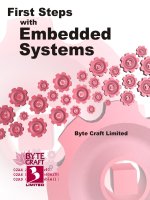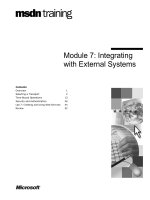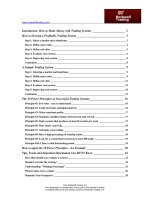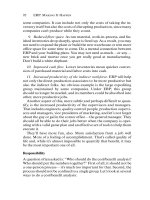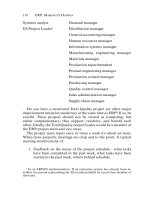Agile innovation innovating with enterprise systems
Bạn đang xem bản rút gọn của tài liệu. Xem và tải ngay bản đầy đủ của tài liệu tại đây (1.66 MB, 256 trang )
AGILE INNOVATION: INNOVATING WITH
ENTERPRISE SYSTEMS
Kamburugamuwa Sachithra Prasadi Lokuge
[Sachithra Lokuge]
BSc. in ICT (Honours), Graduate in Chemistry (Ceylon)
Submitted in fulfilment of the requirements for the degree of
Doctor of Philosophy
Information Systems School
Science and Engineering Faculty
Queensland University of Technology
September 2015
AGILE INNOVATION: INNOVATING WITH
ENTERPRISE SYSTEMS
Kamburugamuwa Sachithra Prasadi Lokuge
[Sachithra Lokuge]
BSc. in ICT (Honours), Graduate in Chemistry (Ceylon)
Principal Supervisor: Associate Professor Darshana Sedera,
Information Systems School, QUT
Associate Supervisors: Professor Suprateek Sarker,
McIntire School of Commerce, University of Virginia
Associate Professor Glen Murphy, Business School, QUT
Agile Innovation: Innovating with Enterprise Systems
i
Keywords
Enterprise Systems, Information Systems, Innovation, Enterprise System Lifecycle,
Enterprise System Lifecycle-wide Innovation, Radical Innovation, Incremental
Innovation, Innovation Lead-time, Innovation Outcomes, Agile Innovation, Metatheory, Instrumental Orchestration Theory, Operand Resources, Operant Resources
ii
Agile Innovation: Innovating with Enterprise Systems
Abstract
In an era of technological advances and hyper-competition, it is no surprise
that the phenomenon of innovation enabled through information systems to achieve
competitive parity is a core topic of interest for scholars and practitioners. While
there is a rich body of literature on innovation, much of the focus has been on
uncovering the antecedents of innovation, or on the diffusion of innovation.
Relatively little attention has been given to the complex process of attaining
innovation, especially innovations enabled through enterprise systems (ES).
Understanding the process of innovation attained through ES is especially critical
given the contradictory beliefs surrounding the role of ES in attaining innovation.
While much of the literature acknowledges the role of ES in innovation, a
considerable number of studies question this view and highlight the rigidity of ES.
Considering the substantial investments made by organisations in implementing and
managing ES and the fact that these systems are rarely replaced or retired, it is
important to understand how contemporary organisations attain innovation through
their ES. Further, the advent of mobile technologies, cloud computing and business
intelligence (referred as digital technologies) has also impacted the way
organisations seek innovation through ES. Thus, this study seeks to address the
limited understanding on innovating through ES and digital technologies.
A qualitative study was conducted, comprising an integrated approach of
deduction phase followed by an induction phase as the research methodology. The
study involved the analysis of data collected through nine case organisations. The
study attempts to understand how organisations innovate through ES and digital
Agile Innovation: Innovating with Enterprise Systems
iii
technologies and also to identify the new advanced role of ES in supporting
innovation.
The results indicate that ES facilitates a new way of attaining innovation
using integration of systems, referred to in this study as “agile innovation,” which
consists of characteristics that differ from existing innovation typologies (i.e.
incremental and radical innovation). Such a new way of innovation is enabled
through the orchestration of multiple components whereby the innovation enables
and triggers IT resources and organisational stakeholders such as executive-level IT
managers and line-of-business managers. The study identifies the specific
characteristics of agile innovation and explains the process of attaining agile
innovation through a meta-theory. Further, as a theoretical extension to the metatheory, the study introduces new modes of orchestration, providing valuable insights
for academics and practitioners.
iv
Agile Innovation: Innovating with Enterprise Systems
Table of Contents
Keywords ............................................................................................................................................... ii
Abstract ................................................................................................................................................. iii
Table of Contents ....................................................................................................................................v
List of Figures ........................................................................................................................................ix
List of Tables ..........................................................................................................................................x
List of Abbreviations ..............................................................................................................................xi
Statement of Original Authorship ........................................................................................................ xii
Acknowledgements ............................................................................................................................. xiii
CHAPTER 1: INTRODUCTION ....................................................................................................... 1
1.1
Research Background ..................................................................................................................4
1.2
Research Problem ........................................................................................................................7
1.3
Theoretical Propositions: Enterprise Systems and Digital Technologies ................................... 12
1.3.1 Enterprise Systems and Innovation ................................................................................. 13
1.3.2 Digital technologies and Innovation ............................................................................... 16
1.4
Research Scope .......................................................................................................................... 18
1.5
Introduction to Methodology ..................................................................................................... 20
1.6
Significance of the study ............................................................................................................ 22
1.7
Thesis Outline ............................................................................................................................ 23
CHAPTER 2: LITERATURE REVIEW ......................................................................................... 25
2.1
Innovation .................................................................................................................................. 26
2.1.1 Defining Innovation ........................................................................................................ 26
Agile Innovation: Innovating with Enterprise Systems
v
2.1.2 Types of Innovation ........................................................................................................ 29
2.1.3 Dimensions of Innovation ............................................................................................... 36
2.1.3.1 Innovation Speed ............................................................................................................ 36
2.1.3.2 Outcomes of Innovation ................................................................................................. 38
2.1.4 Innovation Measures ....................................................................................................... 39
2.2
Enterprise Systems ..................................................................................................................... 41
2.2.1 ES Characteristics and Benefits ...................................................................................... 41
2.2.2 ES Lifecycle ................................................................................................................... 43
2.2.3 ES as a Platform ............................................................................................................. 46
2.3
Characteristics of Digital Technologies ..................................................................................... 49
2.4
Deriving Conceptual Framework ............................................................................................... 50
2.4.1 ES and Innovation........................................................................................................... 50
2.4.2 Digital Technologies and Innovation .............................................................................. 53
2.4.3 IT portfolio as operand and operant IT ........................................................................... 56
2.4.3.1 Enterprise Systems as operand resources ....................................................................... 59
2.4.3.2 Digital technologies as operant resources ....................................................................... 60
2.5
Chapter Summary ...................................................................................................................... 61
CHAPTER 3: RESEARCH METHODOLOGY ............................................................................. 63
3.1
Methodology and Research Design ........................................................................................... 64
3.1.1 Case study method .......................................................................................................... 65
3.1.1.1 Multiple case study method ............................................................................................ 67
3.1.2 Introduction to Induction and Deduction ........................................................................ 69
3.1.3 Methodology followed in the study ................................................................................ 70
3.2
Unit of Analysis ......................................................................................................................... 74
3.3
Sampling Procedure ................................................................................................................... 74
3.4
Case Selection ............................................................................................................................ 76
3.5
Data Collection .......................................................................................................................... 78
3.6
Analysis ..................................................................................................................................... 82
vi
Agile Innovation: Innovating with Enterprise Systems
3.7
Ethical Considerations of the study............................................................................................ 86
3.8
Chapter Summary ...................................................................................................................... 86
CHAPTER 4: RESULTS AND FINDINGS ..................................................................................... 89
4.1
Deduction Phase: Testing the Propositions ................................................................................ 90
4.1.1 Proposition 1: ES facilitates innovation .......................................................................... 91
4.1.2 Proposition 2: Digital technologies facilitate innovation .............................................. 104
4.2
Deduction Phase: Cross-Case Summary .................................................................................. 118
4.2.1 Digital technology-led innovation ................................................................................ 123
4.2.2 Digital Technology’s Reliance on ES ........................................................................... 126
4.3
Induction Phase: Analysis and RESULTS ............................................................................... 129
4.3.1 Data Coding .................................................................................................................. 131
4.4
Agile Innovation ...................................................................................................................... 149
4.4.1 Characteristic 1 – the technology backbone/platform ................................................... 151
4.4.2 Characteristic 2 – the trigger/initiator, scope and outcomes ......................................... 152
4.4.3 Characteristic 3 – collaboration, coordination, configuration and management of
operant and operand resources ...................................................................................... 154
4.4.4 Characteristic 4 – initiate and manage agile innovation ............................................... 155
4.5
Meta-Theory on Agile Innovation ........................................................................................... 157
4.6
Modes of Orchestration............................................................................................................ 166
4.6.1 IT-led orchestration ...................................................................................................... 167
4.6.2 LOB-led orchestration .................................................................................................. 168
4.6.3 Synchronised orchestration ........................................................................................... 169
4.7
Chapter Summary .................................................................................................................... 170
CHAPTER 5: CONCLUSIONS ...................................................................................................... 173
5.1
Summary of Research Findings ............................................................................................... 175
5.2
Limitations of the Study ........................................................................................................... 181
5.3
Contributions to Theory ........................................................................................................... 183
Agile Innovation: Innovating with Enterprise Systems
vii
5.3.1 Orchestrating Technologies .......................................................................................... 184
5.3.2 Agile Innovation ........................................................................................................... 187
5.3.3 Extension of the Meta-theory ....................................................................................... 189
5.4
Contributions to Practice .......................................................................................................... 191
5.5
Future Study Opportunities ...................................................................................................... 196
REFERENCES .................................................................................................................................. 201
APPENDICES ................................................................................................................................... 221
Appendix A: Interview Protocol ......................................................................................................... 221
Deduction Phase....................................................................................................................... 221
Induction Phase ........................................................................................................................ 222
Appendix B: Ethics Approval ............................................................................................................. 225
Appendix C: Profiles of the Case Organisations ................................................................................. 227
1.
LOGISTICS .................................................................................................................. 227
2.
MULTI ......................................................................................................................... 228
3.
ENERGY ...................................................................................................................... 229
4.
FARM ........................................................................................................................... 230
5.
INSURANCE ............................................................................................................... 231
6.
HEALTH ...................................................................................................................... 232
7.
ROAD ........................................................................................................................... 233
8.
TELECOM ................................................................................................................... 234
9.
DAIRY ......................................................................................................................... 235
Appendix D: Comparison of Innovation Types .................................................................................. 237
viii
Agile Innovation: Innovating with Enterprise Systems
List of Figures
Figure 1: Thematic structure of Chapter 1 ..............................................................................................3
Figure 2: Thematic Structure of Chapter 2 ............................................................................................ 25
Figure 3: Variation of system performance in the ES lifecycle (Adapted from Lokuge and
Sedera 2014a) ....................................................................................................................... 44
Figure 4: Augmented value of business processes through ES and digital technologies ...................... 55
Figure 5: Thematic structure of Chapter 3 ............................................................................................ 63
Figure 6: Deductive reasoning Adapted from Trochim (2000) ............................................................. 69
Figure 7: Inductive reasoning Adapted from Trochim (2000) .............................................................. 70
Figure 8: Research Design .................................................................................................................... 74
Figure 9: Thematic representation of Chapter 4 .................................................................................... 89
Figure 10: Digital technology-led innovation ..................................................................................... 124
Figure 11: Sub-categories of project category..................................................................................... 137
Figure 12: Sub-categories of technology category .............................................................................. 138
Figure 13: Sub-categories of innovation category ............................................................................... 138
Figure 14: Sub-categories of human category ..................................................................................... 139
Figure 15: Sub-categories of outcomes category ................................................................................ 139
Figure 16: Agile innovation ................................................................................................................ 148
Figure 17: Exposure of a business process function to outside parties (e.g. customers) through
digital technologies ............................................................................................................ 154
Figure 18: Modes of orchestration ...................................................................................................... 167
Figure 19: Thematic representation of Chapter 5 ................................................................................ 173
Figure 20: The process of Agile Innovation ........................................................................................ 195
Agile Innovation: Innovating with Enterprise Systems
ix
List of Tables
Table 1: Definitions of innovation types ............................................................................................ 31
Table 2: Characteristics of radical and incremental innovation ..................................................... 35
Table 3: Summary of the case organisations .................................................................................... 79
Table 4 : Categories and Codes .......................................................................................................... 83
Table 5: Summary of Cross-Case Analysis - Deductive Analysis ................................................. 121
Table 6: Illustrations of open coding ............................................................................................... 132
Table 7: Axial coding ........................................................................................................................ 142
Table 8: Orchestration key characteristics ..................................................................................... 163
Table 9: Comparison of innovation types ....................................................................................... 239
x
Agile Innovation: Innovating with Enterprise Systems
List of Abbreviations
CIO
- Chief Information Officer
CTO
- Chief Technology Officer
ERP
- Enterprise Resources Planning
ES
- Enterprise Systems
IS
- Information Systems
IT
- Information Technology
LOB
- Line of Business
UHREC
- University Human Research Ethics Committee
Agile Innovation: Innovating with Enterprise Systems
xi
Statement of Original Authorship
QUT Verified Signature
xii
Agile Innovation: Innovating with Enterprise Systems
Acknowledgements
I am indebted to a number of people who contributed to the completion of my
PhD journey. First and foremost, I wish to thank my supervisor, Associate Professor
Darshana Sedera, for his indescribable, unquantifiable support and guidance. His
unswerving confidence in my abilities encouraged me numerous times when the journey
was tough. I cannot imagine a better supervisor and mentor. Apart from the specialist
advice he imparted to me, the true art of hard work is one of the most valuable lessons
that I learnt from him. Thank you, Darshana, for being a pillar of my success.
I wish to extend my appreciation to my associate supervisors, Associate
Professor Glen Murphy and Professor Suprateek Sarker for their support and guidance
throughout this journey. I would also like to thank Professor Varun Grover from
Clemson University, South Carolina and Professor Saonee Sarker from University of
Virginia, Virginia, for their feedback. It was a privilege to work closely with a group of
generous and hard-working professors. I will always treasure the experience I gained
through our interactions. Further, I would like to thank everyone who assisted me in
many different ways, especially the members of the Enterprise Systems Research Group
Agile Innovation: Innovating with Enterprise Systems
xiii
for their insightful feedback and collaboration. I particularly thank Professor Christine
Bruce in the Information Systems School, QUT, for her kindness.
Last but not least, I would like to express my deepest gratitude to my family for
helping me to reach my dream. Especially, I thank my mother, Thattho, Aachchi and my
partner for all the support given to me throughout this journey. Amma, Thattho and
Aachchi – this dissertation is dedicated to you for all the pain you had to go through
because of me. Finally, I would like to thank the love of my life, for being there for me,
and making this tough long road, a journey filled with smiles and happiness. We made it!
xiv
Agile Innovation: Innovating with Enterprise Systems
Chapter 1: Introduction
“If you want something new, you have to stop doing something old.”
― Peter F. Drucker
Innovation has long been a topic of interest among academics and practitioners as a
result of the never-ending competition, market expectations and the pace of technological
advancements (Damanpour 1987; Nagji and Tuff 2012). In the last decade or so, the
emphasis on innovation has undergone considerable change in most industries (Latzer
2009; Nambisan 2013). One simple yet visible change is that innovation has changed
from being a priority of those who wear a lab coat to being a priority of senior executives
worldwide (Maxwell 2009). Innovation has become much more open, global and
collaborative in nature; it involves a diverse network of partners and emphasises
distributed innovation processes (Yoo et al. 2010). Regardless of the industry sector,
many senior executives have embraced new technologies in order to innovate in the
competitive market (Harrison et al. 1997; Kim et al. 2012).
Organisations’ use of information technology (IT) as a source of innovation has
been documented since the 1990s (Swanson 1994). For example, the technology
advancements made during the past few years have assisted organisations to innovate
through enhanced decision-making capabilities (Brynjolfsson 2011; Huber 1990),
increased customer connectedness (Bharadwaj et al. 2013; Kumar et al. 2010), increased
number of channels for reaching customers/suppliers (Bharadwaj 2000; Kleis et al. 2012)
and enhanced communication facilities (Olesen and Myers 1999; Youmans and York
2012). In particular, there has been some evidence of organisations attempting to use
enterprise systems (ES) to increase the efficiency and effectiveness of business
Chapter 1: Introduction
1
processes, products, service development, delivery and administrative functionalities
(Srivardhana and Pawlowski 2007). The introduction of ES creates a ‘radical change’
embedding the idea of possible continuing innovation capabilities through the system
(Kraemmerand et al. 2003). The majority of past studies discuss the influence and
importance of the features and functions of ES that bring forth operational flexibility
(Karimi et al. 2007), business process improvements (Grover and Segars 2005),
productivity (Shang and Seddon 2007), transparency (Akkermans et al. 2003), innovation
(Srivardhana and Pawlowski 2007) and profitability (Romero et al. 2010; Staehr et al.
2012). Yet, the rigid and complex nature of ES has dashed the hopes for continuous
innovation in many organisations and made the system a burden rather than an advantage
(Kharabe et al. 2013; Kharabe and Lyytinen 2012).
The advancement of new technologies has changed the corporate technology
landscape and has opened new pathways for organisations to innovate regardless of their
access to resources (e.g. human and financial) relative to their counterparts (Nylén and
Holmström 2015). In particular, after the dotcom crash, organisations are offered with
enhanced functionalities in information, communication and connectivity technologies
(Bharadwaj et al. 2013). These digital technologies are changing the business landscape
enabling organisations to work globally disregarding the time, distance and the function
(Bharadwaj et al. 2013; Kohli and Grover 2008; Sambamurthy et al. 2003). In the digital
era for the survival in the competitive market, these digital technologies facilitate
organisations different approaches to innovate (Pavlou and El Sawy 2010). Yet, the
existing body of knowledge falls short in explaining the present trajectory of innovation
through the use of digital technologies, which represents a new and different context. In
line with these observations, the focus of this dissertation is on the innovation process
2
Chapter 1: Introduction
through the modern IT portfolio of ES and digital technologies. This chapter provides an
overview of the research, with the structure of this chapter depicted in Figure 1.
Figure 1: Thematic structure of Chapter 1
Chapter 1: Introduction
3
1.1
RESEARCH BACKGROUND
Information systems (IS) scholars have recognised ES as an enabler of innovation
(Seddon et al. 2010; Srivardhana and Pawlowski 2007; Van den Bergh and Viaene
2013). The innate characteristics of ES such as integration, standardisation has enabled
the organisations to innovate by offering increased knowledge capabilities (Srivardhana
and Pawlowski 2007). Yet, the realization of ES capabilities depend on the integration
mechanisms and collaboration among departments (Srivardhana and Pawlowski 2007).
Since the 1990s, organisations have embraced these packaged applications expecting
benefits through standardisation, process orientation, integration, corporate governance
and platform flexibility (Gable et al. 2008; Seddon et al. 2010; Sedera and Gable 2010).
Furthermore, ES purport to introduce best practices (Wagner et al. 2006), bringing
radical changes to business processes (Kraemmerand et al. 2003; Liang et al. 2007).
Several academic studies explicitly or implicitly recognise innovation as a major
outcome or expectation of the advent of ES (Karim et al. 2007; Shang and Seddon 2007),
which is often characterised as a ‘radical change’ (Kraemmerand et al. 2003) to business
processes (Bingi et al. 1999) and management structures (Sasidharan et al. 2012) in the
IS literature. However, scholars question the long-term value of ES for innovation
(Davenport 2000a; Davenport et al. 2004; Dutta et al. 2014; Kemp and Low 2008;
McAfee and Brynjolfsson 2008).
As Swanson and Dans (2000) explain, systems deteriorate over time and eventually
are retired or upgraded. However, as Eden et al. (2014) point out, ES is rarely replaced or
retired, emphasising the need for organisations to continuously innovate using ES.
Studies also outline that organisations are often not ready for lifecycle-wide innovation
through ES (Kemp and Low 2008; Lokuge and Sedera 2014a; Lokuge and Sedera 2014b;
McAfee and Brynjolfsson 2008). Moreover, research on ES use (Burton-Jones and
4
Chapter 1: Introduction
Grange 2012; McLean and Sedera 2010) and ES benefits (Seddon et al. 2010) allude to
the necessity for continuous innovation using ES. ES vendors and implementation
partners are under growing pressure to deliver solutions that lead to lifecycle-wide
innovation (Esteves 2009). ES clients are also under pressure to justify the heavy
resource-intensiveness of ES, to manage skill shortages and to rationalise the continuous
mandatory investments for upgrades (Srivardhana and Pawlowski 2007). Some scholars
suggest that widely accepted ES implementation critical success factors could be
considered for the entire lifecycle to facilitate innovation (King and Burgess 2006).
On the other hand, the effective use of ES is innately challenged by the systems’
lack of flexibility (Kharabe and Lyytinen 2012). In 2007, the practitioner outlet, The
Economist (in Kharabe and Lyytinen 2012), metaphorically describe ES as ‘liquid
concrete,’ stating that “implementing SAP [a leading enterprise system] is like pouring
concrete into a company.” However, ES vendors eliminated some of the inflexible
features of ES and enhanced openness of ES. As a result ES is now evolving to take a
more salient role as a technology platform (Schenk 2015). The ‘ES technology platform’
is facilitating an ecosystem of third-party software products, services, technologies and
suppliers to integrate with the ES, paving a new path for organisations to innovate
(Ceccagnoli et al. 2012).
Since the mid-2000s, corporate IT has been presented with an opportunistic flux
triggered by the growth in the consumerization of IT and the advent (and rapid adoption)
of mobiles technologies, cloud computing and business intelligence. These changes have
created an ecosystem of providers and suppliers of tools, techniques and practices,
beyond the conventional boundaries (Adomavicius et al. 2008; Harris et al. 2012; Yoo et
al. 2012), providing opportunities for organisations to reach their customers directly
through corporate IT (Martín-Rojas et al. 2013). As such, the decisions related to
Chapter 1: Introduction
5
corporate IT consumption and strategy are no longer the exclusive responsibility of IT
managers. Recent studies and anecdotal evidence suggest that end-users actively demand
IT applications that can be consumed through mobile technologies, the cloud and this
usage is contributing to strategic IT (Kopetzky et al. 2013; Leeson 2013; Park and Ryoo
2013).
Cloud computing, mobile technologies and business intelligence (including big
data)—referred to collectively as ‘digital technologies’—denote a broad and evolving set
of models of highly distributed computing and related solutions that rely on open,
heterogeneous, ubiquitous network services and associated protocols (Chee and Franklin
Jr 2010). The digital technologies are defined as combinations of information, computing
and connectivity technologies in the current era. Similar references have been made in
Nambisan (2013), Yoo et al. (2012), Nylén and Holmström (2015) and Bharadwaj et al.
(2013). Many scholars and practitioners argue that digital technologies are transforming
business processes and practices in a new way that enable new types of innovation
processes (Berman et al. 2012; Nylén and Holmström 2015; Stahl et al. 2012). Tiwana et
al. (2010), for example, highlight the importance of the integrative nature of digital
platforms such as mobile technologies for creativity, innovation and growth. Although
studies have identified the benefits of end-to-end core business process coverage through
ES (Palaniswamy and Frank 2000), anecdotal evidence suggests that organisations
employ digital technologies at the functional level. This is a substantial departure from
the traditional corporate software foundation (Davenport 2000a), and marks a new era of
corporate computing.
6
Chapter 1: Introduction
1.2
RESEARCH PROBLEM
The “importance of innovation to organisational competitiveness” (Wolfe 1994,
p.405) has been acknowledged by many scholars (e.g. Teece 1992). This point of view is
particularly relevant in the current era, when the use of digital technologies within
organisations is found to foster continuous innovation (Nylén and Holmström 2015; Yoo
et al. 2012). Thus, it is no surprise that IS scholars are increasingly focusing on
understanding the organisational innovation that is triggered and facilitated by digital
technologies.
The term ‘innovation’ in this research refers to ‘organisational innovation’ which
encompasses product, process, administrative and technological innovations that emerge
due to the use of technologies such as ES and digital technologies within the
organisational boundaries. This study subscribes to the definition of organisational
innovation proposed by Crossan and Apaydin (2010, p. 1155) as the “production or
adoption, assimilation, and exploitation of a value-added novelty in economic and social
spheres; renewal and enlargement of products, services, and markets; development of
new methods of production; and establishment of new management systems.” This
definition provides a generalised view of innovation, taking into account the innovation
that takes place in everyday organisations. It goes beyond the definitions that ideate
innovation as a “new-to-the-world” concept (e.g. Garcia and Calantone 2002). This
definition captures internally-initiated innovations, as well as adopted (imitated)
innovations. For the majority of common organisations dealing with common products or
services, the term ‘innovation’ does not resonate with the new-to-the-world concept, as it
would for technology or manufacturing innovators like Google, Apple Inc. or BMW.
Thus, past innovation studies, typically measuring innovation through patents (Xue et al.
2012), new products and new markets (Lyytinen and Rose 2003) or using Tobin’s-Q
Chapter 1: Introduction
7
(Adams et al. 2006), have been criticised for lacking relevance to day-to-day innovation
pursuits as the common business practices would rarely involve the creation of patents or
even the allocation of dedicated research and development funds (Adams et al. 1992;
Cordero 1990). Researchers (e.g. Lai et al. 2009; Lyytinen and Rose 2003) concur with
the view that innovation need not be a totally new concept to the world and could even be
considered as an imitation of something already used elsewhere, but new to the unit of
adoption.
As such, this research studies innovation in relation to common business
practices. For an organisation to be considered innovative in the present market
conditions, it demands consideration of how the organisation faces challenging
environments swiftly, effectively and mindfully (Swanson and Ramiller 2004).
Furthermore, being innovative also means how ordinary organisations move quickly out
of political and social turbulences (Melville et al. 2004).
Wolfe (1994, p.406) argues that given the “complex, context-sensitive nature of
the phenomenon itself [innovation],” it is advisable for innovation researchers to focus on
a particular stream of innovation, which can be related to: (i) the diffusion of innovation,
(ii) the antecedents of an organisation’s propensity to innovate, or (iii) the innovation
process itself. While there is a strong tradition of research on the diffusion of innovation
(Rogers 1995), the antecedents of innovation (Jansen et al. 2006), and even some aspects
of organisational innovation (Camisón and Villar-López 2014; Damanpour 1991; Hage
1999), the existing body of knowledge falls short in explaining the black box of the
innovation process (Swanson and Wang 2005) – how to innovate with ES in the presence
of digital technologies.
Yoo et al. (2012) argue that the process of innovation itself has shifted
dramatically in recent times, thus requiring a separate investigation. For example, with
8
Chapter 1: Introduction
the advancement of digital technologies the process of innovation has become faster,
unstable, rapid and difficult to control and predict (Henfridsson et al. 2014; Nylén and
Holmström 2015; Yoo et al. 2012). Digital technologies are redesigning the traditional
innovation processes and enabling the organisations to carry out business functions
across boundaries of time, distance, and function (Bharadwaj et al. 2013; Kohli and
Grover 2008). As Bharadwaj et al. (2013) explain the innate characteristics of digital
technologies facilitate the organisations to connect better with the stakeholders such as
customers, vendors and employees. Further, scholars such as Henfridsson et al. (2014)
and Nylén and Holmström (2015) concur with the idea that the advancement of the
digital technologies facilitate new types of innovation processes.
ES is one of the largest corporate systems aim to streamline the majority of
business processes and enhance the efficiency and effectiveness of the organisational
processes (Kharabe et al. 2013). However, it is evident that even though these systems
introduce radical changes in the organisation in the beginning, they impede the
continuous innovation potential required to survive in the contemporary competitive
business environment. In the recent volatile markets, organisations are keen to seek out
opportunities to be agile (Tallon and Pinsonneault 2011). Especially, organisations focus
on increasing efficiency, reducing costs and attaining higher productivity using their
existing systems such as ES.
Researchers such as Aral et al. (2006) have empirically shown that ES has been a
significant and causal source of increased productivity and efficiency in organisation.
Moreover, ES initiatives are considered as the most lengthy and expensive IT projects of
contemporary organisations (Markus et al. 2000; Scott and Vessey 2002). As Rettig
(2007) states organisations end up spending hundreds of millions of dollars on ES. Thus,
Chapter 1: Introduction
9
